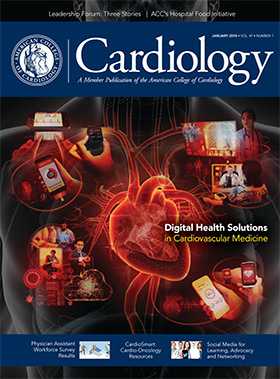JACC in a Flash
Featured topics and Editors’ Picks from all of ACC’s JACC Journals.
Global Health Committee Issues Report on Heart Disease Burden
The United States must prioritize its health resources toward detecting and treating noncommunicable diseases (NCDs), such as cardiovascular disease, while maintaining and expanding prevention and eradication of infectious diseases on a global scale, according to a detailed review of global health policy recommendations pertaining to the detection and management of cardiovascular disease put forth by a committee of the National Academies of Sciences, Engineering and Medicine (NASEM) this past May.
The NASEM committee was charged with identifying current global health priorities and making strategic recommendations to the U.S. government and other stakeholders on how best to address these priorities in a manner that would have the most immediate and substantial impact. Their recommendations — 14 in total — were released in May 2017 and included improving early detection and treatment; mitigating disease risk factors; shifting global health infrastructure to include management of cardiovascular disease; developing global partners and private-public ventures to meet infrastructure and funding challenges; streamlining medical product development and supply; increasing research and development capacity; and addressing gaps in global political and institutional leadership to meet the shifting challenge. Read More >>>
In the review article, published recently in the Journal of the American College of Cardiology, the authors focus on the cardiovascular disease-related recommendations, providing insights in five key areas: 1) global cardiovascular health; 2) screening for early detection and treatment of cardiovascular disease; 3) catalyzing innovation, including accelerating drug development, addressing research and development capacity and leveraging digital health; 4) smart financing strategies; and 5) global health leadership.
"These NASEM recommendations and this manuscript are among the most important efforts of my career, because if they are adopted by the U.S. government, they have the potential to enact true change for global health."
“The Committee has highlighted priority areas that demand continued investment and underscored the imperative to change the way the United States approaches global health, to a more proactive and integrated strategy,” the authors write. “One targeted area is CVD, as part of general expansion of the global health vision to encompass chronic NCDs. The outcome of investment in global health, now shifting to include NCDs, will be resilient countries with positive health outcomes, robust trade partners, safer travel destinations, and more active collaborators in preventing and controlling global health problems that affect citizens of every country, at every income level.”
Should the U.S. choose to prioritize cardiovascular disease and other NCD programs within its global health strategy, the authors stress the country could benefit in the following three ways: 1) adoption of a universal purpose; 2) economic prosperity and trade benefits; and 3) the safeguarding of U.S. global health investments.
“These NASEM recommendations and this manuscript are among the most important efforts of my career, because if they are adopted by the U.S. government, they have the potential to enact true change for global health,” says corresponding author Valentin Fuster, MD, PhD, MACC. “The next step for the committee is to present these recommendations to the U.S. Senate and to President Donald J. Trump.”
Fuster V, Frazer J, Snair M, et al. J Am Coll Cardiol 2017;Nov 30:[Epub ahead of print].
Overcoming Payer Obstacles in the Development of CV Therapeutics

Regulators and payers may have different priorities in the development of cardiovascular therapeutics, leading to obstacles and delays in patient access to new treatments, according to an article published in the Journal of the American College of Cardiology.
Faiez Zannad, MD, PhD, et al., describe interactions among regulatory agencies, payers, sponsors and investigators, and propose collaboration among all stakeholders earlier in the development process. They highlight the current complexities in both the U.S. and European health care systems, explaining how in the U.S. there is a substantial difference in reimbursement practices among various payers and reimbursement decision-making is not transparent. In Europe, the process for reimbursement decisions is based on the predominance of single payer systems and the ability of national organizations to negotiate pricing. Both the U.S. and Europe, however, are actively working to advance the steps toward early alignment. Read More >>>
“Earlier and predictable patient access to effective new cardiovascular therapies is the primary goal underpinning proposals to collaboratively engage regulatory and payer representatives in pre-approval drug development decisions,” the authors write. They also suggest that transparency and accountability can be shown by defining requirements for reimbursement before regulatory approval. They explain that implementing strong scientific standards for cost effectiveness or other analyses used in reimbursement decision-making can help achieve greater transparency and acceptance of reimbursement decisions.
While consistency and quality of payer interactions are questionable, steps are still being taken to promote earlier interaction among regulators and payers in North America, Europe and other parts of the world. For example, although it is limited, the U.S. allows both the Federal Drug Administration and Centers for Medicare and Medicaid Services to concurrently review data about medical devices to incorporate both perspectives into a single clinical trial. Europe has also taken steps to advance progress toward early interaction by engaging a variety of tools to handle uncertainty from lack of information about budget impact, cost effectiveness, use in real life and access.
Additionally, the authors explain that greater resource allocation is needed for updating data on efficacy and safety, and revoking either regulatory or reimbursement approvals should not be underestimated.
“There is no easy solution, but collaborative engagement of regulators, payers, health technology assessment bodies, pharmaceutical companies, academic leaders, investigators, patients, physicians, professional organizations, and other health care providers represents an important step to developing a system that reflects the views and needs of all stakeholders,” the authors write.
Zannad F, Alonso Garcia MLA, Borer JS, et al. J Am Coll Cardiol 2017;70:2822-30.
Report Establishes Next Steps to Better Understand Fontan-Associated Liver Disease
A better understanding of the current gaps in knowledge, clinical care and research of Fontan-associated liver disease (FALD) is critical to the development of a standardized prevention, screening and treatment approach for Fontan patients, according to a report published in the Journal of the American College of Cardiology.
Curt J. Daniels, MD, FACC, et al., summarize findings from an earlier meeting of FALD stakeholders and establish a platform to better understand and address FALD. As the majority of patients born with single-ventricle anatomy who had the Fontan operation as children have reached adulthood, FALD has emerged as a late extracardiac complication. FALD and other late complications have a negative effect on patients’ quality of life and could lead to premature death. Read More >>>
Although survival rates to adulthood for patients with congenital heart disease (CHD) is close to 90 percent, survival rates to a similar age for patients with severe CHD, including those with single-ventricle anatomy, is much lower at 56 percent. In addition, long-term follow up of patients who had the Fontan procedure suggests 59 percent freedom from adverse cardiovascular events five years post operation, but only 29 percent freedom after 15 years. This suggests an “important emerging medical crisis,” the authors write.
According to the report, an accurate definition of FALD that is widely recognized is necessary for investigators to conduct research that will lead to improved understanding of FALD epidemiology, causation, pathophysiology, prevention and treatment. In addition, research into cardiac and extracardiac mechanisms that contribute to patients’ risk for FALD could help identify those at higher risk of the disease and enable earlier screening. A longitudinal registry of patients who have had the Fontan procedure could help advance these research efforts, according to the report.
The report committee recommends several practices for prevention, screening and treatment of FALD. For prevention, the authors advise that providers focus on optimizing underlying Fontan physiology and preventing liver injury before and after a Fontan operation. Screening for FALD should, at a minimum, include baseline liver function tests five years post Fontan operation for children, or sooner if a liver injury or Fontan failure is suspected. Adults and adolescents who have had the Fontan procedure should have liver function tests every one to three years. Routine physicals should include laboratory studies; evaluation of Hepatitis A, B and C exposure; and liver imaging. In addition, the report outlines considerations for Fontan patients undergoing evaluation for heart or liver transplantation or combined heart and liver transplantation.
Collaboration between health care societies and organizations, research institutions and subspecialists involved in treatment of Fontan patients will be critical to mobilizing resources necessary to improve understanding and treatment of FALD. The authors conclude that moving forward, “We need an investment toward research and technologies post-Fontan operation that matches our past and current commitment to pre-Fontan patients.”
Daniels CJ, Bradley EA, Landzberg MJ, et al. J Am Coll Cardiol 2017;70:3173-94.
Keywords: ACC Publications, Cardiology Magazine, Academies and Institutes, Adolescent, Cardiovascular Diseases, Child, Cost-Benefit Analysis, Follow-Up Studies, Fontan Procedure, Global Health, Health Personnel, Health Priorities, Health Resources, Heart Diseases, Hepatitis A, Leadership, Liver Diseases, Liver Function Tests, Liver Transplantation, Medicaid, Medicare, Mortality, Premature, North America, Pharmaceutical Preparations, Quality of Life, Registries, Research, Research Personnel, Research Personnel, Resource Allocation, Risk Factors, Single-Payer System, Social Responsibility, Survival Rate, Technology Assessment, Biomedical, Uncertainty
< Back to Listings

